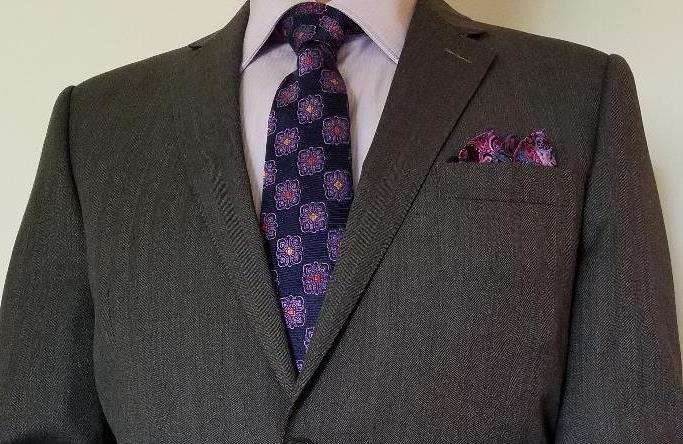In the mid-1950’s there was a best-selling novel entitled The Man in the Gray-Flannel Suit. The novel centered on the life of a man who commuted daily into the City from the suburbs and usually wore a gray-flannel suit like so many of his middle-class neighbors. The grey-flannel suit was in actuality a uniform—a uniform that symbolized conformity and mediocrity. Furthermore, the central character was racked with angst and guilt.
Now let us fast forward seventy years to another man: The Man in the Afternoon Suit.
Who is the Man in the Afternoon Suit?
I first encountered The Man in the Afternoon Suit at one of the many charity luncheons that I would dattend at New York’s renowned 21 Club. At these luncheons most of the men were bankers and lawyers, who would come to the Club directly from their offices and so would be dressed in their customary business attire, usually dark-blue pinstriped suits. But The Man in the Afternoon Suit was dressed in no such way; for he wore a mid-to light gray suit—or was it light brown checked suit? I’m not sure which. But what I am sure is that if he had an office, he was hardly ever there. And as for guilt, he exhibited none, but instead projected a great joie de vivre. He seemed to know everyone; and if he didn’t know someone, well, for him a stranger was simply a friend you haven’t yet met. And as for angst, he exhibited none, instead projecting great conviviality and self-confidence.
So who was The Man in the Afternoon Suit? Was he a playwright? An art dealer? An entrepreneur? I never found out because he was always surrounded by so many people—most of whom were women. What I was certain of was that if he did work, he could be depended on to rearrange his schedule on short notice for an invitation to an important luncheon or an afternoon tea.
The Origin of The Afternoon Suit
To understand the origin of The Afternoon Suit, one most look to the upper strata of English Society in the 19th Century, and particularly the English Gentleman. In that period a Gentleman was not expected to work or have an occupation other than those in the highest echelons of the Law, or perhaps the Military or the Clergy or Politics. To have a business was not only frowned upon, it would surely get you bounced from a listing in Burke’s Landed Gentry (somewhat akin to the American Social Register). So essentially he was a member of the leisure class: an English Gentlemen of the period had considerable time available to attend afternoon teas in the drawing rooms of socially prominent women. And in doing so, he was expected to dress appropriately. And what was that? Well, that is not as important as what it was not. It was definitely not formal (e.g. a Morning Suit), nor a suit that he would wear when dressing for dinner ( e.g. White Tie and Tails).
The Prince of Wales
Now let us jump to the end of the 19th Century. Great changes were being made in the way English Gentlemen dressed (and American Gentlemen, too). And the instigator of these changes was none other than the Prince of Wales (i.e., the male heir to the English throne). He championed a less formal style for Gentlemen. And that can be seen in what would become to be known as the Prince of Wales Suit. The question is which Prince of Wales are we talking about: the one that became known as King Edward VIII and abdicated his throne to become known as the Duke of Windsor (in the first half of the 20th Century)? Or an earlier Prince of Wales, his grandfather, who became Edward VII?
Suffice to say that both Princes of Wales favored Glen check (i.e. Glen plaid) suits. The earlier Prince of Wales is said to have modified the traditional Glen check by adding brown and cream to the characteristic black and white checks of the fabric, while the latter Prince of Wales is said to have added a blue and red overlay to the pattern. It is important to note that the earlier Prince of Wales originated the suit primarily for hunting, while the latter favored it for day-time official/social occasions for which formal dress or a uniform would not be appropriate.
The Prince of Wales Suit Today
Unfortunately, I have no pictures of a contemporary Prince of Wales suit to show you. That may be a blessing in disguise, for I am not sure that there is any consensus as to what a Prince of Wales Suit actually is. Is it the same as a glen check or plaid suit? Is it only a gray suit or are there other colors mixed in? I am sure that the current Prince of Wales (Prince Charles) does own a suit that he or his bespoke tailors believe to be an authentic Prince of Wales; however, most of the suits I have seem him wear during the day are of the striped variety.
James Bond and The Prince of Wales Suit
Ironically, the foremost wearer of the Prince of Wales suit is not a real person but a fictional one: Agent 007—James Bond. The purported Prince of Wales suits worn by the movie actors who have portrayed James Bond are indeed iconic; and I say “purported” because you have to be able to closely examine their fabric to be able to determine whether they are truly Prince of Wales or are just gray Glen Checks.
But whether James Bond wears an authentic Prince of Wales Suit or not, he is certainly the quintessential wearer of The Afternoon Suit. And what a splendid icon he is . Does he have a traditional 9 to 5 job and work in an office? Of course not, he is a spy (a spy for us that is). Furthermore, he is never too busy in the afternoon to find time to dispatch a fearful villain or have a liaison with a fetching woman—villainous or not.
What Makes a Suit An Afternoon Suit?
So what then is The Afternoon Suit? Is it a Prince of Wales Suit? Not necessarily. What the Afternoon Suit is, as I define it, is a suit that identifies the wearer as someone who is not a traditional salaried person or professional (he could be an architect, though). He is, so to speak, his own man; and the way that he dresses clearly expresses that.
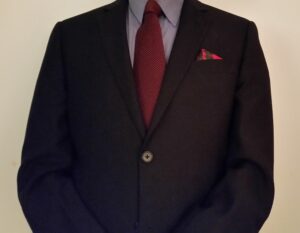
What characterizes the Afternoon Suit is not so much what it is but what it is not. It is not a business suit, such a navy pinstriped suit; nor is it an evening suit that one would wear to cocktail parties (e.g. a dark blue suit). Both aforementioned suits are worn to allow the wearer to fit in. But The Man In The Afternoon Suit is not interested in fitting-in. That doesn’t mean that the wearer is intent on making a fashion statement. But what it does mean is that rather than fitting-in, he blends-in. He is always appropriately dressed for any afternoon function; yet how he does it appears to be a mystery. But now we will reveal just how he pulls it off.
The Ideal Afternoon Suit
The secret of the Afternoon Suit is instead of the suit overwhelming, it is the accessories that stand out. And for that purpose a medium-gray wool suit is ideal. Such a suit goes with the color of any accessory, as the color gray is essentially neutral.
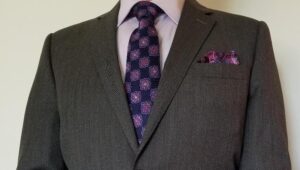
The ideal Afternoon Suit will have a subtle pattern; you certainly do not want a sharkskin suit, as that would be too shiny. But the pattern of an Afternoon Suit can be tricky. Yes, you can have a Glen check or Prince of Wales pattern, but it shouldn’t be noticeable more than six feet away. That is why I favor a herringbone pattern, as you can see above. Now, if you have a beautiful bespoke Italian or English suit made of sumptuous fabric—and perhaps double breasted as well—by all means wear it, as long as it is not a business suit. But bear in mind that if you do, you will overwhelm the accessories that I will describe for you next.
How to Accessorize the Afternoon Suit
There are three major accessories that stylize the look of The Afternoon Suit; they are the shirt, the tie and the pocket square. For example, for a conservative look, one that I might wear for a staid luncheon for a charity—one that is replete with “old-money” attendees–I would definitely wear a white shirt, a subdued tie and a white linen pocket square with a presidential (square) fold, as you see below.
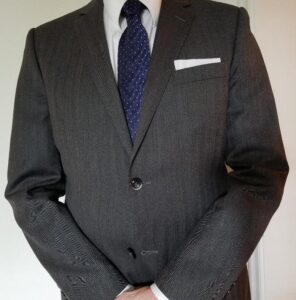
However, if I were attending a luncheon for the patrons of a ballet company, I would be more bold, choosing a lavender shirt, and a tie and pocket square with a great deal of purple in them. And furthermore, I would use a three-point fold for the pocket square, as pictured below.
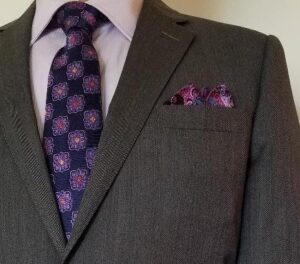
How to Wear the Afternoon Suit for the Person—Not Just The Event
The Afternoon Suit can be stylized not just for the event (e.g. a luncheon) but for a particular person or persons. For example, if I were having lunch with a woman who is a corporate lawyer, I might go with a conservative look with a white shirt, as previously shown; however if the woman I am having lunch with is an artist, my stylization might reflect that with a fuchsia-striped shirt with a tie and pocket square with a lot of red in them, as shown below.
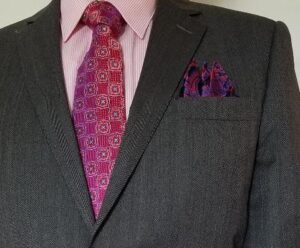
Other Accessories
For the Afternoon Suit (or any suit for that matter), ditch the bling. You don’t need it. If you are wearing a shirt with French Cuffs, choose understated but tasteful cufflinks. And if you must wear a watch—why does anyone need to wear a watch today?—choose a minimalist watch with a leather watchband, not some clunky chronograph sports watch with a metal watch band.
Foot Wear
For the Afternoon Suit I would recommend a pair of Double Monk shoes with distinctive hosiery, such as burgundy herringbone socks, as shown below.
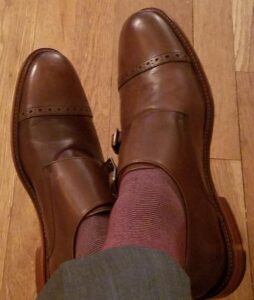
However, if you truely feel that you need something more conservative, go with a pair of black tasseled loafers. But by all means do not wear a lace-up shoe; that would be much too conservative.
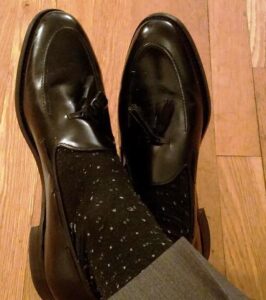
Where to Wear The Afternoon Suit
It is nice to own distinctive clothing, but it is better yet to have a place to where them. If you live in the New York area here are some places where you would not be out of place wearing The Afternoon Suit.
First, there is the Russian Tea Room. It is now open, for, as you can imagine, afternoon tea.
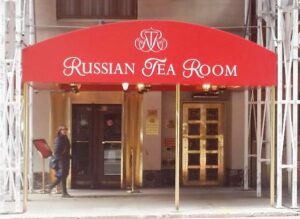
Next, there is the Palm Court of the Plaza Hotel, recently reopened. Its afternoon tea is also a treasure.
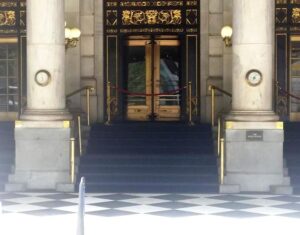
Last but not least, there is the 21 Club. This former speakeasy is closed and it is not known if and when it will reopen. That is a shame, because it is as New York as you can get: many Oscar-winning motion pictures have filmed scenes there.

The Afternoon Suit is not a particular garment but a concept instead. In London it may be an authentic Prince of Wales Suit. In New York it may be a gray herringbone wool suit. In the Southern United States, it may be a seersucker suit. And in Beverly Hills, it may not be a suit at all, but a sports jacket with an open-collared shirt (no tie).
The garment may change and so, too, the locale. But what never changes is the Wearer. He is always his own man.
